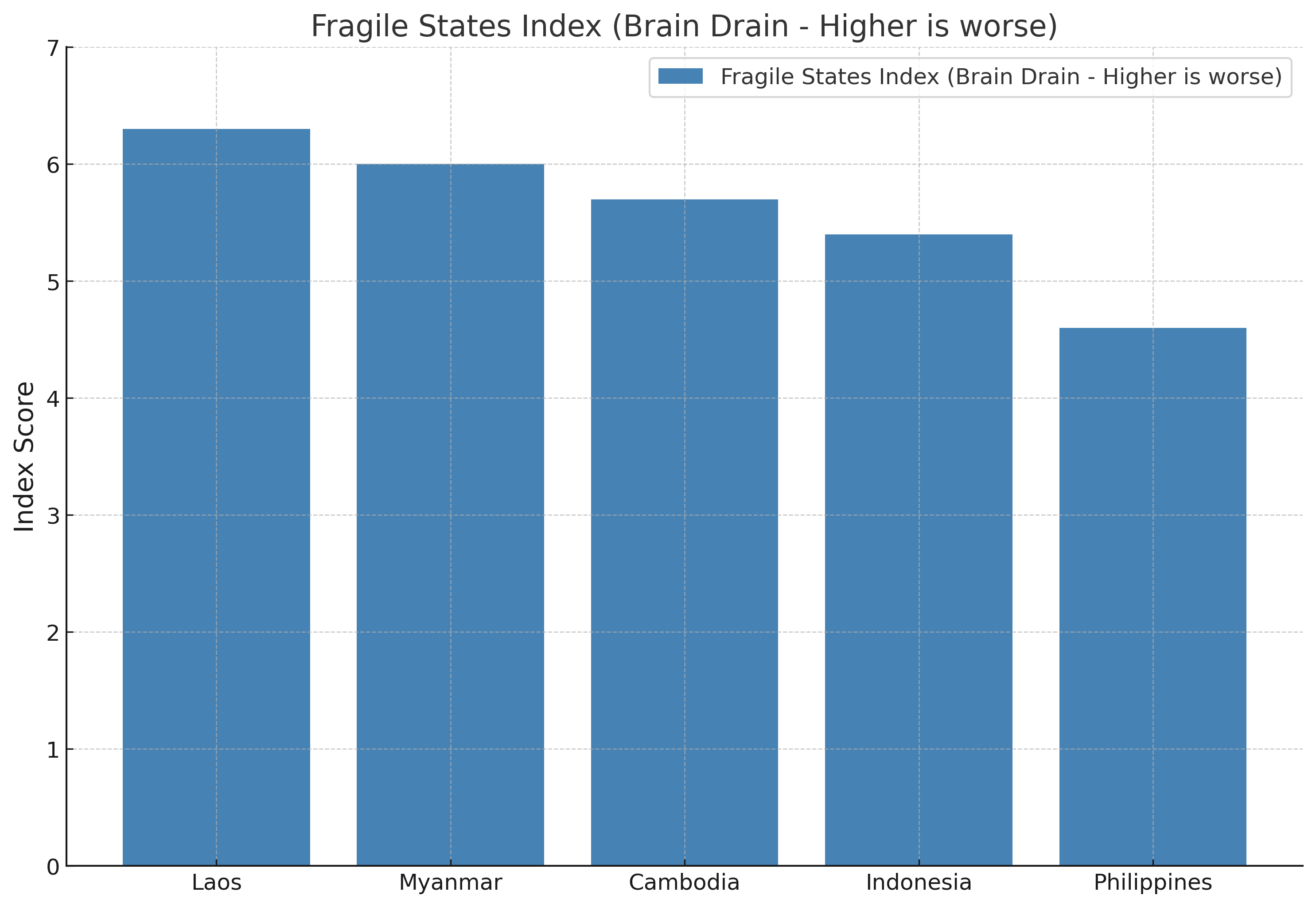Southeast Asia presents prosperous opportunities alongside a challenging recruitment landscape in 2025, marked by, like most other markets, quickening digital transformation and the growing adoption of AI-powered tools across business operations.
Fortunately, this change is happening amidst strong regional growth, with a projected 4.9% expansion for 2025 according to the Asian Development Bank. This easily outpaces the global market’s anticipated 3.1% GDP growth in 2025, according to the OECD.
While this economic “groundfloor opportunity” creates legitimate opportunities for substantial growth, it simultaneously fuels intense competition for top talent, with pronounced skills shortages across critical industries like technology, healthcare, and renewable energy.
Our analysis tells us companies must adapt to quickly changing hiring processes driven by advances in technology, while still understanding nuanced geopolitical factors. Successfully operating in Southeast Asia’s varied hiring environments demands a refined understanding of region-specific challenges.
These challenges range from talent scarcity and cultural diversity to varied regulations and competitive pressures, along with the implementation of nimble, localised answers.
This article offers real-world, actionable strategies to overcome these hiring hurdles, offering recruitment professionals and business leaders specific approaches to attract, secure, and retain top talent in Southeast Asia. By understanding these region-specific challenges, you will gain a measurable competitive advantage in building high-performing teams across diverse Southeast Asian markets.
Challenge 1: Talent Scarcity and Widening Skills Gaps in Southeast Asia
Pervasive Shortage of Specialised Skills
Our research shows it is clear that Southeast Asia faces a critical shortage of talent in 2025, especially professionals with specialised skills. The demand for experts in technology-focused areas (e.g. software development, data science, artificial intelligence, cybersecurity, and cloud computing) is surging region-wide, creating intense competition among employers.
Country-specific challenges highlight the severity: Thailand struggles with a significant digital skills gap despite technology hub ambitions, while Indonesia faces a potentially catastrophic shortage of 9 million skilled and semi-skilled ICT workers between 2015 and 2030, notably in digital and AI disciplines.
The World Economic Forum reports that 53% of businesses globally have difficulties sourcing IT talent with the necessary skills, showing that Southeast Asia is competing for the same rare talent on the global stage.
Beyond technical expertise, soft skills prove equally vital. Research suggests that approximately 85% of long-term job success stems from soft skills, with just 15% attributable to technical knowledge. Consequently, employers increasingly prioritise candidates demonstrating strong communication, adaptability, critical thinking, and leadership abilities.
The “Brain Drain” Phenomenon
The talent shortage is compounded by the ever-present “brain drain”, where highly skilled professionals emigrate for better opportunities overseas. This flight of human capital, heightened by restrictive labour policies in some Southeast Asian nations, depletes local talent pools and stymies development.
The Fragile States Index for 2024 shows several Southeast Asian nations suffering the worst from human flight and brain drain in the region. As shown in Figure 1 below, Laos tops the vulnerability scale at 6.3 (on a 10-point scale where higher scores indicate greater vulnerability), followed by Myanmar (6.0), Cambodia (5.7), Indonesia (5.4), and the Philippines (4.6).
These scores, all above the midpoint, reveal a concerning pattern of talent exodus across the region’s developing economies.
 Figure 1: Human Flight and Brain Drain Vulnerability Index in Southeast Asia (2024). Higher scores indicate greater vulnerability to talent exodus on a scale of 0-10. Source: Fragile States Index
Figure 1: Human Flight and Brain Drain Vulnerability Index in Southeast Asia (2024). Higher scores indicate greater vulnerability to talent exodus on a scale of 0-10. Source: Fragile States Index
Further statistics paint an even more dramatic picture. For example, Malaysia has seen approximately 1.86 million citizens emigrating over 5 decades, representing 5.6% of its population. This outflow stems largely from financial considerations like high living costs and unemployment, rather than socio-cultural dissatisfaction. Key sectors, including healthcare, research, and digital development, suffer particularly.
The Philippines has seen 51% of its licensed nurses (316,000 professionals) emigrate by 2021, predominantly to the United States. Vietnam ranks 3rd globally for students studying abroad, with up to 80% of self-financed students not returning after completing their education.
These talent deficits obviously restrict innovation, especially in fast-growing sectors like cloud computing and renewable energy, while limiting attractiveness for foreign investment and slowing economic development.
Related Read: Why is a Successful Talent Acquisition Strategy Crucial for Business Growth?
Challenge 2: Cultural Diversity and Workplace Integration in Southeast Asia
The Myth of “One-Size-Fits-All”
A critical mistake we have seen many foreign employers make when hiring in Southeast Asia is treating the region as monolithic. In reality, it is made up of 11 distinct markets:
- Brunei
- Cambodia
- Indonesia
- Laos
- Malaysia
- Myanmar
- Philippines
- Singapore
- Thailand
- Timor-Leste (East Timor)
- Vietnam
Each nation, like any other in the world, has unique challenges and cultural norms. It’s for this reason, we’ve seen that generic region-wide strategies consistently underperform.
In our experience, cultural context significantly influences recruitment:
- In Thailand, hierarchical structures are deeply respected. We have even seen technically excellent candidates overlooked if they lack cultural sensitivity.
- Vietnam’s young, ambitious talent pool brings retention challenges, as newly-minted local professionals will quickly seek new opportunities without clear growth pathways at home.
- Indonesia requires local language proficiency. Foreign companies can falter by operating solely with expatriate talent, underestimating local leadership needs.
Diversity, Equity, and Inclusion Challenges
Despite DEI advancements, ASEAN firms struggle with ageism, ethnic diversity, and gender equality. Only one-third of surveyed organisations are addressing age and ethnicity as an issue, and one-third report equal pay for men and women with similar qualifications.
The business case to improve in this regard is compelling: McKinsey found that companies with women’s representation exceeding 30% are significantly more likely to financially outperform those with fewer women, while those in the top quartile for ethnic diversity show an average 27% financial advantage.
Strategic Solutions for Common Hiring Challenges in Southeast Asia
At InCorp, our work across multiple Southeast Asian markets has given us direct insight into effective approaches for talent acquisition. Based on our regional experience, we recommend these practical solutions:
Building Future-Ready Workforces
We have found that talent development is crucial for addressing skills shortages. The World Economic Forum expresses the urgency, saying 62 out of 100 Southeast Asian workers require training by 2030.
 Figure 3: Global and Regional Upskilling Requirements
Source: World Economic Forum Report
Figure 3: Global and Regional Upskilling Requirements
Source: World Economic Forum Report
We recommend connecting with government initiatives like Singapore’s SkillsFuture, Malaysia’s MDEC partnerships, and Vietnam’s National AI Strategy to build capabilities and close talent gaps.
Fostering Cultural Agility and Inclusion
Cultural awareness training makes measurable differences in team effectiveness across Southeast Asia’s varied backgrounds. Develop culturally appropriate onboarding that addresses local customs. As we mentioned earlier, ethnic representation substantially increases profits.
Support local leadership by adjusting management approaches to suit local cultural hierarchical structures while supporting professionals’ growth aspirations. With proven on-the-ground experience and relationships in multiple Southeast Asian markets, InCorp can be an invaluable partner in this area.
Winning and Keeping Top Talent
Spend time creating compelling value propositions for skilled professionals. With 86% researching company reputation before applying, genuine employer branding creates advantages. Design market-specific reward packages – for example, we have found that Malaysian and Thai professionals value bonuses, for example, while Vietnamese candidates often prioritise support for housing and training, and Indonesians value fuel stipends.
Also consider remote or hybrid working arrangements – for example, 91% of Filipino workers want hybrid or remote options, with hybrid models creating the highest employee satisfaction.
Where to Next With InCorp
We hope that we have clearly explained that Southeast Asia’s hiring challenges require more than surface-level solutions. The region’s talent scarcity, cultural complexities, intense competition, and geopolitical pressures demand expertise that comes from genuine market experience.
Success depends on understanding that effective recruitment strategies must balance global best practices with local market realities.
At InCorp, we have helped companies across Southeast Asia build sustainable talent acquisition strategies that work. Our integrated approach combines deep regional knowledge with robust experience, giving you the foundation for long-term hiring success.
Ready to solve your Southeast Asian hiring challenges? Contact InCorp today to discuss how our regional recruitment expertise and comprehensive services can help you attract, secure, and retain the talent your business needs to thrive across Southeast Asia’s dynamic markets.
FAQs about Hiring Challenges in Southeast Asia
What are the biggest hiring challenges in Southeast Asia in 2025?
- Primary challenges include critical talent shortages in technology and healthcare sectors, complex cultural diversity requiring tailored approaches for each market, and intense competition for skilled professionals driving up salary expectations across the region.
Why is cultural awareness important for hiring in Southeast Asia?
- Southeast Asia comprises 11 distinct markets with unique cultural norms and business practices. Cultural awareness training and localised management approaches significantly improve team effectiveness and retention rates.
How can companies address the skills gap in Southeast Asian markets?
- We recommend companies should invest in upskilling and reskilling programmes, adopt skills-based hiring that focuses on practical abilities rather than credentials, partner with government initiatives like Singapore's SkillsFuture or Malaysia's MDEC programmes, and create internal mobility pathways.


